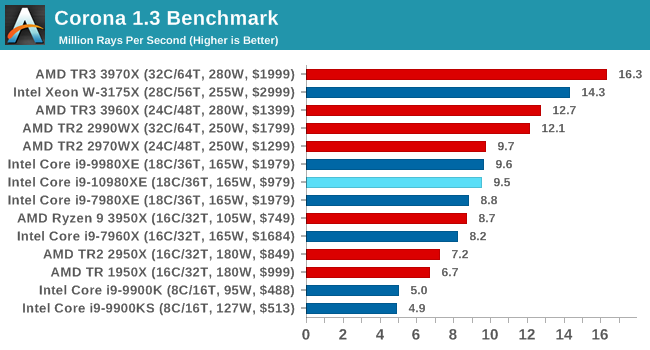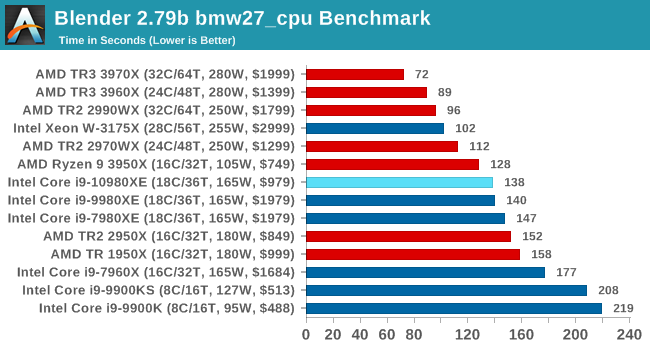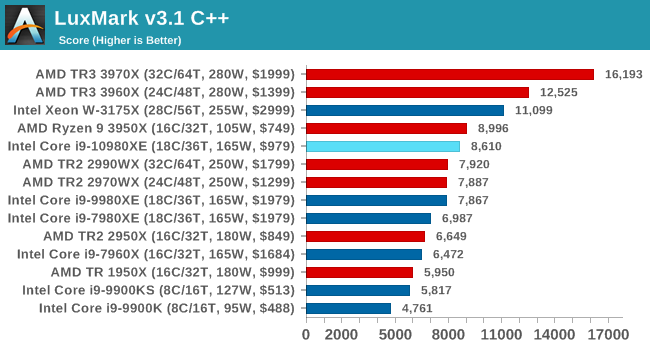It’s a Cascade of 14nm CPUs: AnandTech’s Intel Core i9-10980XE Review
by Dr. Ian Cutress on November 25, 2019 9:00 AM ESTCPU Performance: Rendering Tests
Rendering is often a key target for processor workloads, lending itself to a professional environment. It comes in different formats as well, from 3D rendering through rasterization, such as games, or by ray tracing, and invokes the ability of the software to manage meshes, textures, collisions, aliasing, physics (in animations), and discarding unnecessary work. Most renderers offer CPU code paths, while a few use GPUs and select environments use FPGAs or dedicated ASICs. For big studios however, CPUs are still the hardware of choice.
All of our benchmark results can also be found in our benchmark engine, Bench.
Corona 1.3: Performance Render
An advanced performance based renderer for software such as 3ds Max and Cinema 4D, the Corona benchmark renders a generated scene as a standard under its 1.3 software version. Normally the GUI implementation of the benchmark shows the scene being built, and allows the user to upload the result as a ‘time to complete’.
We got in contact with the developer who gave us a command line version of the benchmark that does a direct output of results. Rather than reporting time, we report the average number of rays per second across six runs, as the performance scaling of a result per unit time is typically visually easier to understand.
The Corona benchmark website can be found at https://corona-renderer.com/benchmark

The 10980XE sits on par with the 9980XE, but no real difference in performance.
Blender 2.79b: 3D Creation Suite
A high profile rendering tool, Blender is open-source allowing for massive amounts of configurability, and is used by a number of high-profile animation studios worldwide. The organization recently released a Blender benchmark package, a couple of weeks after we had narrowed our Blender test for our new suite, however their test can take over an hour. For our results, we run one of the sub-tests in that suite through the command line - a standard ‘bmw27’ scene in CPU only mode, and measure the time to complete the render.
Blender can be downloaded at https://www.blender.org/download/

Again, pretty much on par with the 9980XE.
LuxMark v3.1: LuxRender via Different Code Paths
As stated at the top, there are many different ways to process rendering data: CPU, GPU, Accelerator, and others. On top of that, there are many frameworks and APIs in which to program, depending on how the software will be used. LuxMark, a benchmark developed using the LuxRender engine, offers several different scenes and APIs.
In our test, we run the simple ‘Ball’ scene. This scene starts with a rough render and slowly improves the quality over two minutes, giving a final result in what is essentially an average ‘kilorays per second’.

We see a small uplift here compared to the 9980XE, but the 10980XE still sits behind the 3950X.
POV-Ray 3.7.1: Ray Tracing
The Persistence of Vision ray tracing engine is another well-known benchmarking tool, which was in a state of relative hibernation until AMD released its Zen processors, to which suddenly both Intel and AMD were submitting code to the main branch of the open source project. For our test, we use the built-in benchmark for all-cores, called from the command line.
POV-Ray can be downloaded from http://www.povray.org/

Another parity between the 10980XE and the 9980XE.











79 Comments
View All Comments
Santoval - Monday, November 25, 2019 - link
Wait for the prices of both to adjust first.Drumsticks - Monday, November 25, 2019 - link
I don't care about process nodes, as long as they're delivering competitive prices, core counts, and performance per core. Intel's not quite out of the game yet since AMD's HEDT goes higher than Intel's, but they've gotten smashed at the halo spot, and they won't be able to deliver on price and performance if they can't get something in order.Braincruser - Tuesday, November 26, 2019 - link
No they haven't been "smashed at the halo spot". The 3900X and 3950X are both beasts and both shred in most of the important benchmarks. For video rendering both the 3900x and 3950X hand out with both the threadrippers and the intels. You get 90% of the performance for 1/4th the price. 12-16 cores is also a very important number for programmers, since you have enough CPUs for compiling, and running 2-3 VMs comfortably.Dolda2000 - Monday, November 25, 2019 - link
Why is it that Intel gains so incredibly much more from AVX512 than AMD gains from AVX2?In the 3DPM2 test, the AMD CPUs gain roughly a factor of two in performance, which is exactly what I'd expect given that AVX2 is twice as wide as standard SSE. The Intel CPUs, on the other hand, gain almost a factor of 9, which is more than twice what I'd expect given that AVX512 as four times as wide as SSE.
What causes this? Does AVX512 have some other kind of tricks up its sleeves? Does opmasking benefit 3DPM2?
Xyler94 - Monday, November 25, 2019 - link
Basically, AVX-512 is double the performance of AVX2 (or another way to see it, 256bit vs 512bits, which 512 is double 256). So anything optimized for 512 will be about double in speed from 256, even on the exact same processor.Xyler94 - Monday, November 25, 2019 - link
To note: That's a highly overly simplistic view of it, there's a lot more under the hood.eek2121 - Monday, November 25, 2019 - link
Well that and the obvious point that AMD CPUs do not support AVX-512.DanNeely - Monday, November 25, 2019 - link
AVX-2 is 256 bits wide, and thus only does have as much/instruction as AVX-512.JayNor - Monday, November 25, 2019 - link
I believe for 10 cores and up there are dual avx512 units per core. You can see the dual avx512 units in the Execution Engine diagram at this link.https://en.wikichip.org/wiki/intel/microarchitectu...
Also, cascade lake added dlboost 8 bit operations in avx512 to support ai inference convolutions.
Dolda2000 - Monday, November 25, 2019 - link
But Zen 1/2 also has two 256-bit FMAs per core. And Intel also has two SSE units per core as well, so I don't see how that would explain the ratios.